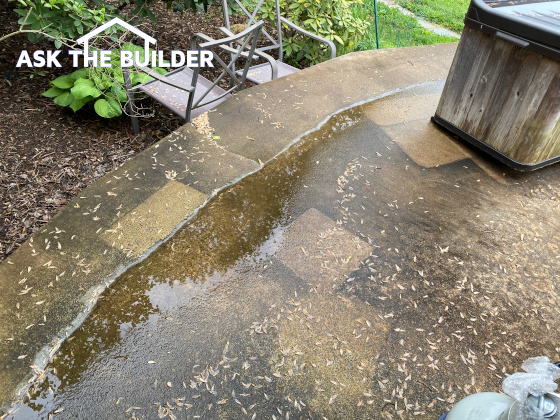Fixing Puddles on Patios, Driveways and Slabs

Here’s a pesky puddle on an outdoor patio. Kids delight in them, but they make some adults simmer like a steak on a searing outdoor grill. Copyright 2020 Tim Carter
Patio Puddles
DEAR TIM: I’ve got a problem I need you to solve. You see each time it rains I have a puddle develop on the outer edge of my circular patio. It’s older concrete and it appears the puddle is related to a crack that’s above a low retaining wall the patio rests on. Can I just fill in where the puddle is and all will be well? I am worried about the appearance of the patch and how might I disguise my attempt to stop the ponding water? I only want to fix this one time. What are my options? Amy P., Warrenton, VA
Do you have a problem with puddling similar to Amy’s? I see puddles frequently and even have the issue here at my own home where there are depressions in my asphalt driveway and where my front sidewalk meets my drive. It’s important to realize I didn’t build the house I currently live in.
Amy’s repair is not that hard to do, but she threw in a wildcard with respect to what the repair will look like. You may be like Amy and want your outdoor patio to look nice instead of a hodgepodge of different colors and textures. Amy was kind enough to send me excellent photos of her situation and I can tell you that it would be next to impossible to install a patch that blended in perfectly so only a trained eye could tell the patio was patched. You can see all the photos on my AsktheBuilder.com website.
There’s another issue in play with respect to Amy’s repair. She mentioned there’s a crack in the patio that’s directly related to the low curved retaining wall. Remember that she also said she wants to make the repair once. Failure is not an option.
When you add all these pieces of the puzzle together, you only come up with one repair option in my book. Amy needs to do a thin, perhaps just 2 inches, concrete overlay. You may disagree with my choice, but keep in mind she wants the repair to look great and long-lasting.
Concrete overlays can come in a variety of flavors. You can do one as thin as a coat of stucco! This means the overlay is really just fine sand and cement. It’s possible to get the overlay as thin as 1/8-inch, but 1/4-inch would be an easier project to manage for the DIYr inside you.
If Amy hired me to write the simple set of specifications for her job so she could get really accurate bids and be sure the job would be done right here’s what I’d go with.
I’d want the concrete overlay to be 2 inches thick where it starts at the outer edge of the concrete patio where it passes over the low retaining wall. Before I’d even start to do the work, I’d cut a scrap piece of wood 2 inches thick and place it on the outer edge of the patio. Then I’d rest a straightedge on the small piece of wood.
I’d want to check to see how thick the overlay would be when it got back to the house making sure the patio had a consistent slope of 1/8-inch per foot. This way rainwater would drain off the patio with ease. You can get by with 1/16th-inch per foot, but it takes an expert concrete finisher to maintain this slope and not create a new puddle in the middle of the new overlay! Remember, Amy wants this repair done once.
The concrete would have small pencil reinforcing rods in it. These rods are 3/8-inch in diameter. I’d prime and paint them with a rust-resistant paint before the job would begin as I don’t want the rods to start to deteriorate in case Amy broadcasts salt on the patio in the winter months. These rods must have at least 1/2-inch of concrete under them when the overlay is poured.
I’d make sure the spacing of the rods was 2-feet-on-center both directions. Imagine creating a giant piece of graph paper but using the steel rods as the lines. This steel ensures the overlay will stay together as one piece and not have settlement issues where part of the slab drops lower than an adjacent piece as is happening over the retaining wall.
The size of the stones in this concrete overlay is very critical. I’d not want any stone to be larger than 3/8-inch in diameter. Some gravel pits sell a gravel called pea gravel where the stones are round and about the size of small grapes, none being larger than 3/8-inch in diameter. You can also use small crushed gravel that’s a similar size.
I’d specify a seven-bag mix which makes the concrete stronger than the minimum 4,000 pounds-per-square-inch strength recommended for outdoor slabs in a cold climate. My specifications would also state to be sure to pressure wash the existing concrete patio to get a great bond between the old and new concrete.
I’d list as an option the application of a thin layer of cement paint to the old damp concrete before the pour. The steel rods make this quite problematic. If you have enough helpers present, you can do this cement paint application with them brushing it on the damp concrete just before it’s covered with the new overlay concrete. You make cement paint mixing pure Portland cement with water until it’s the consistency of normal paint.
Keep in mind you can add color to the concrete! You can purchase dry-shake pigments and make your new patio look like leather or even the sky!
Column 1352
3 Responses to Fixing Puddles on Patios, Driveways and Slabs